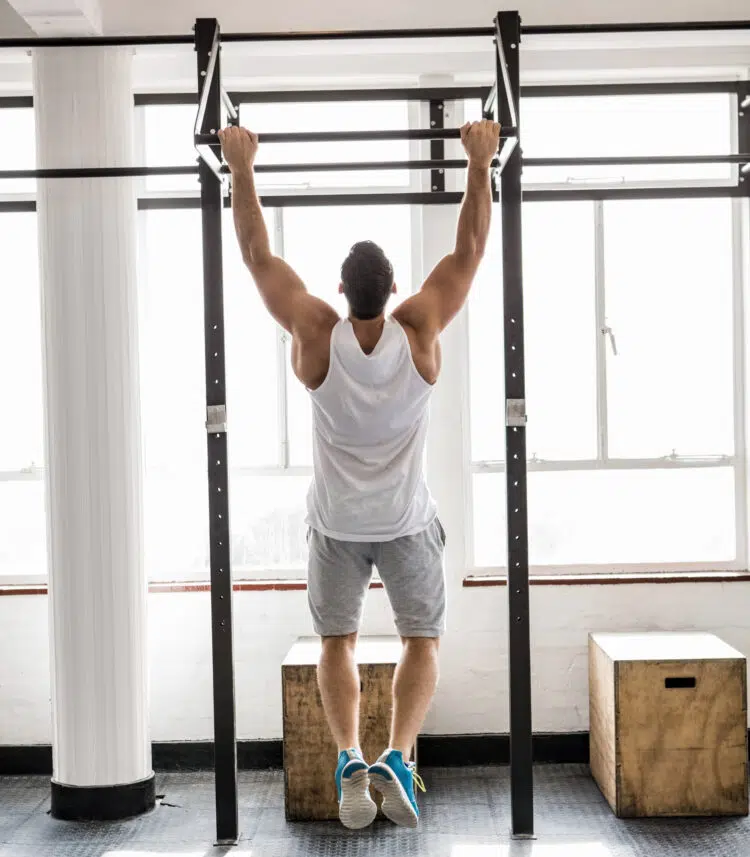When most people think about fitness and achieving their best physique ever, they usually imagine grueling workouts that leave them exhausted for the rest of the day. However, this is all a myth.
The best fitness routine will vary for each individual and can be as simple as hanging onto a pull-up bar for two minutes daily.
Many never start their fitness journey because they cannot make the time to hit the gym every day. However, a sedentary lifestyle and no physical exercise is a recipe for disaster.
As a personal trainer with over 17 years of hands-on experience, I start many of my clients with a simple two-minute dead hang routine. While this might sound too simple (and ineffective), it is one of the best exercises for the upper back, shoulders, core, forearms, and hand and wrist flexors.
In this article, I take you over how doing dead hangs for two minutes daily can transform your body. I’ll also share a simple 30-day challenge that you can implement into your own routine to experience the benefits firsthand.
Science-Backed Benefits of Hanging
Level Up Your Fitness: Join our 💪 strong community in Fitness Volt Newsletter. Get daily inspiration, expert-backed workouts, nutrition tips, the latest in strength sports, and the support you need to reach your goals. Subscribe for free!
Dead hangs, also known as the brachial hangs, lengthen the spine, decompress the discs, and strengthen the upper body. Experts believe dead hangs are a combination of yoga, pilates, and strength training. Here are the advantages of adding this exercise to your routine:
Decreased Pain
Dead hangs are an isometric exercise, meaning they involve contracting multiple muscle groups while applying a large force but without significantly changing the muscle lengths or joint angles. This makes it excellent for people already dealing with muscle, tendon, or joint pain or discomfort.
Dead hangs are also used by physiotherapists as a posture correction exercise. It can also be an incredibly effective exercise for relieving shoulder, mid-back, and lower back pain (1). A study concluded that eight weeks of stretching the spine can decrease the cervical pain level by an average of almost 39 percent. (2)
During a dead hang, you are essentially employing gravity to decompress the spine, which is usually induced by sitting or standing throughout the day, leading to pain and reduced height.
Improved Posture
I cannot stress this enough: Dead hangs are one of the most effective exercises for folks who spend most of their day sitting. Several clients tell me they have grown taller by an inch since incorporating dead hangs into their routine.
While more research is needed to prove that hanging onto a bar can help adults grow taller, experts agree that dead hangs decompresses and elongates the spine, which can correct posture issues like a hunched back that can add a few inches to your height.
Builds Strength
Hanging onto an elevated surface recruits all the upper body muscle groups, including the arms, shoulders, biceps, back, chest, abs, and forearms.
Experienced lifters usually dismiss dead hangs as a beginner exercise. However, this is where they go wrong. You are in for a surprise if you have never tried dead hangs before. As a personal trainer who has trained hundreds of people, I can attest that most people have a hard time hanging onto the bar for 30 seconds.
The numbers dip further when you tell them to do multiple sets of this exercise. You are as strong as your grip strength on this exercise. Once your grip strength goes, it can take five to 15 minutes to recover.
I also have my beginner clients do multiple sets of dead hangs daily to help them get to their first bodyweight unassisted pull-up.
Pro Tip: Lifters performing this exercise to improve their lat mind-muscle connection should consider using lifting straps. This eliminates grip limitations, allowing you to focus on the target muscles.
Injury Rehab

Most rehabilitation routines involve low-impact exercises for optimal target muscle stimulation and growth. Many practitioners recommend dead hangs for shoulder recovery.
Raising your arms overhead gives the supraspinatus tendon room to move and stretch without getting pinched, which is usually the case when you raise the arms in front of your body and parallel to the floor.
Dead hangs are an excellent exercise to stretch and reshape the supraspinatus tendon and the surrounding muscles and bones, speeding up recovery.
That said, people dealing with existing health issues must consult their healthcare provider before starting a new exercise or diet routine. Recovering from a chronic or acute shoulder injury can involve medication, mobility work, and rotator cuff prehab.
Level Up Your Fitness: Join our 💪 strong community in Fitness Volt Newsletter. Get daily inspiration, expert-backed workouts, nutrition tips, the latest in strength sports, and the support you need to reach your goals. Subscribe for free!
“Doing dead hangs for 30 seconds three times per day can cure 99 percent of shoulder pain,” said Dr. John M. Kirsch, an orthopedic surgeon and author of the bestseller book Shoulder Pain? (2010)
Boosts Grip Strength & Lung Function
Many people don’t fully understand the importance of grip strength. Research shows that older adults with low grip strength are at a greater likelihood of premature mortality, the development of disability, and an increased risk of complications or prolonged length of stay after hospitalization or surgery. (3)
People who routinely do dead hangs would agree that breathing during this exercise can be a challenge. This is because hanging onto an overhead bar mechanically compresses the chest. The good news is that this can improve lung function in the long term.
The two-minute hang is a shortcut to get all the benefits of a dedicated structured spine decompression-focused stretching routine.
Mastering the Dead Hang Technique
Hanging onto a bar for an extended period is serious business. However, one of the best parts about dead hangs is that they are not too difficult to learn and perform correctly. Here is how to perform this exercise with a picture-perfect form:
- Stand on an elevated surface under a secure overhead bar.
- Grab the bar with a shoulder-wide overhand grip.
- Move your feet off the bench or aerobic stepper so you’re hanging on to the bar.
- Ensure your elbows and shoulder blades are fully extended.
- Keep your neck, head, and spine neutral and core braced throughout the exercise to maintain a steady position.
- Beginners should aim for a 10-second hang, whereas intermediate lifters should gun for 30-45 seconds.
- Repeat for three sets.
- Focus on slowly increasing the hang time.
Pro Tip: I advise against jumping and hanging onto a pull-up bar as it makes it more challenging to establish a secure grip. It can also put unnecessary strain on the wrist, elbows, and shoulder joints.
Dead Hang Variations For People of Varying Experience Levels
Add the following exercises to your arsenal based on your experience level:
Beginners
- Shorter Durations: Complete beginners should aim for short hangs (1-5 seconds).
- Assisted Hangs: Use a chair or box to support your weight during the set and take tension off your joints.
Intermediate
- Leg Raises: During the two-minute dead hand, engage your core by performing leg raises.
- Kipping: An excellent way to build upper body mobility and strength to progress toward more challenging exercises like toes-to-bar and muscle ups.
Advanced
- One-Arm Hangs: Test your strength and coordination by hanging onto the bar with just one hand.
- Weighted Hangs: Once two-minute hangs start feeling too easy, make the exercise more challenging by wearing a weighted vest or dip belt.
30-Day Hanging Challenge
The dead hang is one of the most overlooked exercises. All the benefits you read about in the previous section can be achieved within four to eight weeks. To help you get there, I have designed a comprehensive 30-day hanging challenge suitable for people of all experience levels.
Week One: Building a Foundation
Since hanging for two minutes daily cannot cause significant systematic fatigue, you must aim to do it every day.
| Days | Sets | Hang Time (seconds) | Rest (seconds) |
| 1-3 | 3 | 10 | 30 |
| 4-7 | 3 | 15 | 30 |
Week Two: Progressive Overload
Maintain perfect form throughout the exercise to maximize target muscle stimulation.
| Days | Sets | Hang Time (seconds) | Rest (seconds) |
| 8-10 | 3 | 20 | 30 |
| 11-14 | 3 | 30 | 45 |
Week Three: Strength Gains
As the days progress, the hanging time will increase, and so will the rest durations.
| Days | Sets | Hang Time (seconds) | Rest (seconds) |
| 15-17 | 3 | 40 | 45 |
| 18-21 | 3 | 45 | 60 |
Week Four: Aiming For Old
You’ll be making significant jumps in the final week to maximize your work capacity. Stretch your upper body muscles during the rest time to flush out the metabolites and boost recovery.
| Days | Sets | Hang Time (seconds) | Rest (seconds) |
| 22-24 | 3 | 60 | 60 |
| 25-28 | 2 | 90 | 90 |
| 29-30 | 1 | 120 | 120 |
If you do everything exactly as mentioned in this article, you will most likely be able to hang onto an overhead bar for two minutes by the end of the 30 days.
Feel free to rest for longer during the final week to ensure longer hang times. Starting a set with fatigued muscles can hamper your performance.
Things To Consider While Performing Dead Hangs
Here are the considerations to remember:
- Start Slow: Newbies should begin with shorter durations (10-15 seconds). Aiming for longer holds initially can strain the shoulder joint.
- Avoid Pain: Discontinue a hang if you feel a sharp pain or discomfort. Seek medical advice if the pain doesn’t subside.
- Warm-Up: Perform a few exercises like arm swings to loosen up the upper body muscles and joints and avoid muscle sprains.
Make no mistake, you shouldn’t give up yoga, pilates, and strength training in favor of dead hangs. These three training regimens offer multiple benefits that can improve your overall health and well-being.
Instead, two-minute dead hangs are excellent quick fixes for people who cannot make the time to exercise for 10 to 30 minutes daily. That said, you must stick to this routine for the long term to get the most out of it.
Conclusion
Dead hangs target the upper back, shoulders, core, forearms, and hand and wrist flexors and are an excellent exercise for lengthening the spine, decompressing the discs, and strengthening the upper body.
Use the 30-day blueprint listed in this article to work toward an unassisted two-minute dead hang. Most of my clients also report improved mobility and flexibility by the end of this challenge. Best of luck!
If you have any questions about the two-minute dead hangs or need help implementing them into your routine, post them in the comments below, and I’ll be happy to help!
References:
- Kim D, Cho M, Park Y, Yang Y. Effect of an exercise program for posture correction on musculoskeletal pain. J Phys Ther Sci. 2015;27(6):1791-1794. doi:10.1589/jpts.27.1791
- Jeong, E.J., & Chae, Y. (2012). The Effects of Self-Stretching on Shoulder Pain and Shoulder Flexibility of Hospital Nurses.
- Bohannon R. W. (2008). Hand-grip dynamometry predicts future outcomes in aging adults. Journal of Geriatric Physical Therapy (2001), 31(1), 3–10.










